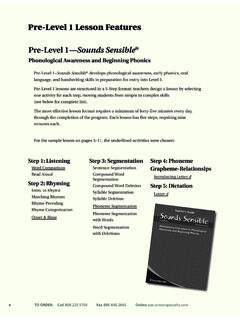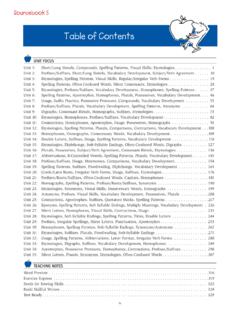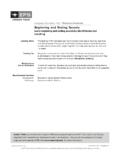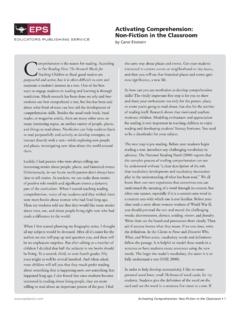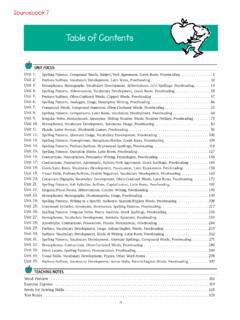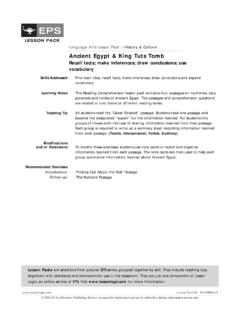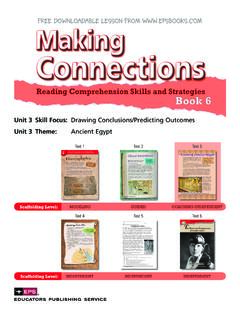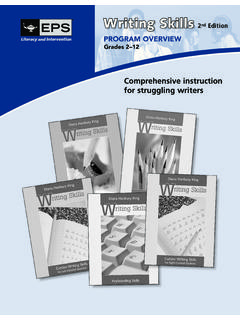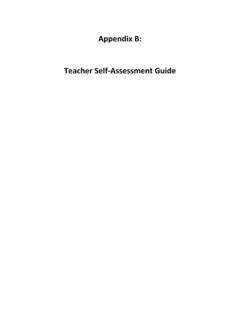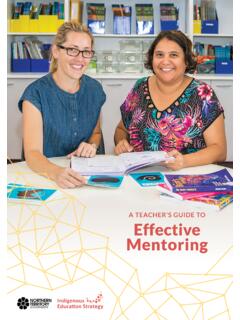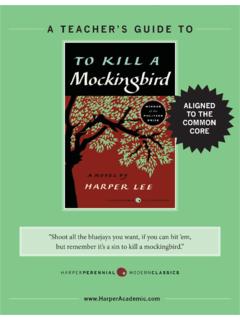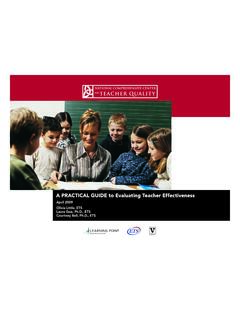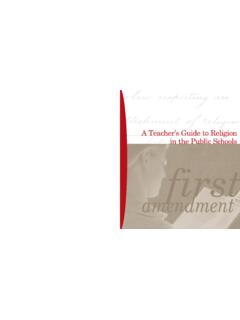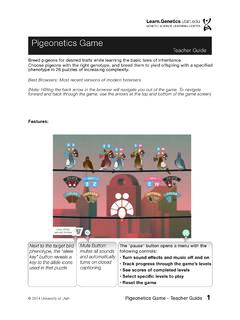Transcription of DECODABLE READERS TEACHER’S GUIDE Sets 1–6
1 DECODABLE READERS teacher S GUIDES pecialized Program Individualizing Reading ExcellenceSpecialized Program Individualizing Reading ExcellenceEDUCATORS PUBLISHING SERVICESets 1 6 2013 by Educators Publishing Service. All rights part of this book may be reproduced in any form or by any electronic or mechanical means, including printing or photocopying, without permission in writing from the 07 2013 ISBN: 978-0-8388-3966-9To learn more about EPS and , visit Table of ContentsINTRODUCTION 1 DECODABLE READERS 2 What Makes a Book DECODABLE ? 2 How Can DECODABLE Books Help Early READERS and Struggling READERS ? 4 DECODABLE READERS and the Common Core State Standards 5 THE APPROACH TO READING 8 Using DECODABLE READERS in Classroom Phonics Instruction 10 Foundational Skill Activities DECODABLE READERS SCOPE AND SEQUENCE OF SKILLS 14 Sets 1A and 1B 14 Sets 2A and 2B 15 Sets 3A and 3B 16 Sets 4A and 4B 17 Sets 5A and 5B 18 Sets 6A and 6B 19 TAKING ADVANTAGE OF DEVICE FEATURES 20 Modifying the Look of the Text 20 Highlighting, Note-Taking, and Bookmarking 21 Looking Up Definitions of Words 22 PURCHASING DECODABLE READERS 24 FOR MORE INFORMATION DECODABLE READERS teacher s GUIDE 1 INTRODUCTIONFrom school textbooks, to job applications, to online news articles, reading is part of our everyday lives.
2 This is one of the reasons that reading and language arts are given so much attention in curriculum development and in policy making. It is also why millions of dollars have been spent on government-sponsored programs such as No Child Left Behind and why the Common Core State Standards in English Language Arts have been developed. In order to be a successful adult, one must be able to read and comprehend text with variety of best practices in the teaching of reading have passed in and out of favor over the years. However, it is clear that having a strong foundation of basic reading skills benefits students as they tackle complex texts, allowing them to focus not only on the act of reading itself, but on understanding and evaluating the information that is good grasp of phonological awareness, phonemic awareness, and phonics is essential to building a strong foundation for reading. This knowledge allows children to move onto more complex reading skills, such as fluency and comprehension.
3 The vast majority of children must be taught the code that is, the connection between sounds and the symbols that represent them. While all children need practice with sound-symbol correspondence, those who struggle with reading need far more of it. This is where DECODABLE texts can be especially beneficial. They play a key role in solidifying foundational reading skills because they include only those phonics skills that children have already been taught. With the knowledge that c says /k/, a says /a/, and t says /t/, children can read the word cat. Early success breaking the code is a powerful experience for young READERS , enabling them to focus on reading with expression and understanding. These READERS will enjoy reading and do more of it, which leads to even greater reading achievement. DECODABLE READERS teacher s GUIDE 2 DECODABLE READERSWhat Makes a Book DECODABLE ?While non-educators may think of DECODABLE books as ones that are merely easy to read, this is not the whole story.
4 The term DECODABLE refers to words that contain only those phonic elements a child has already learned. For example, if the child has learned all the consonants and the short vowel sound of the letter e, the child can be expected to read, or decode, words such as pen, net, and Ben. Most DECODABLE books also introduce a number of sight words. Some of these are phonically irregular. Others are words that will become DECODABLE once the child has learned more phonic elements. As more phonic elements and sight words are introduced, the child becomes a more masterful Luck?Focus Concept: ck (clock)*Sight words are nonpatterned or very low-patterned words of high frequency. Sight Words*a, his, I, is, into, of, said, the, The, to, whatConsonant Sounds all consonantssh (ship)ch (chin)th (this, thin)wh (whisk)ff (cliff)ll (will)ss (miss)qu (quilt)Welded Soundsang (sang)ing (ring)ong (strong)ung (stung)ank (bank)ink (wink) onk (honk)unk (trunk)Vowel Soundsa (ax)i (hit)o (ox)u (up)e (bed)al (ball)wa (wasp)Previously Taught Skillsbackdockduckducksluckquackrocksack snackstuckyuckBad Luck, Set 2 AEach DECODABLE reader includes lists of focus concept words, sight words, and concepts the reader will already need to have mastered.
5 DECODABLE READERS teacher s GUIDE 3 When choosing DECODABLE books for a child, take a look at the skills addressed in each title to make sure they align with what the child has already learned. A list of skills covered in the DECODABLE READERS series can be found beginning on page and His Pup, Set 1 BThe content of the DECODABLE READERS series ranges in difficulty, from easy-to-read, one-syllable, short-vowel words in Set 1, to complex multisyllabic words and advanced sentence structures in Set 6. DECODABLE READERS teacher s GUIDE 4 Valley Forge, Set 6 AHow Can DECODABLE Books Help Early READERS and Struggling READERS ?Reading is not a skill that comes naturally; it must be learned. Some children pick it up with less support than others, but all children benefit from instruction in phonics: that is, instruction in the sounds that letters represent and how these letters are combined to make words. Those who struggle with reading especially need to spend dedicated time developing their phonics skills.
6 DECODABLE READERS teacher s GUIDE 5 Reading DECODABLE books can benefit students at all ability levels by enabling them to: read independently after learning just a few letters and their sounds; sound out unfamiliar words, which makes students reading more accurate and discourages bad habits, such as skipping over unknown words or guessing what the words say, based on the first few letters; apply the phonics skills they ve learned in the context of a story or nonfiction text; experience success and develop confidence in their reading READERS and the Common Core State StandardsDecodable READERS play an important role in curricula designed to meet the Common Core State Standards (CCSS)*. The CCSS say this about what they call the Foundational Skills: These foundational skills identified are not an end in and of themselves; rather they are necessary and important components of an effective, comprehensive reading program designed to develop proficient (CCSS, 15).
7 The Foundational Skills identified are Print Concepts, Phonological Awareness, Phonics and Word Recognition (decoding), and fifth grade, the expectation (CCSS, 15 17) is that students will be able to do the following: Demonstrate understanding of the organization and basic features of print Demonstrate understanding of spoken words, syllables, and sounds (phonemes) Know and apply grade-level phonics and word-analysis skills when decoding words Read with sufficient accuracy and fluency to support comprehension * National Governors Association Center for Best Practices & Council of Chief State School Officers. (2010). Common Core State Standards for English language arts and literacy in history/social studies, science, and technical subjects. Washington, DC: Authors. DECODABLE READERS teacher s GUIDE 6 DECODABLE books provide connected text students can use to practice their newly acquired reading skills. While students often have opportunities to decode words in isolation, DECODABLE books provide the additional challenge of reading for meaning, which is the ultimate goal of all reading.
8 As such, DECODABLE texts may be considered the first step on the so-called staircase of text complexity that is discussed in the Common Core State Standards. DECODABLE texts are not meant to replace other kinds of books. Rather, they should be used as a tool to precede and facilitate the reading of more challenging s Game, Set 2 BDetailed black-and-white illustrations facilitate comprehension without distracting students from the reading task at hand. DECODABLE READERS teacher s GUIDE 7 The Loris, Set 5 AFor specific activities using DECODABLE READERS to meet the Foundational Skills (K 5) Standards, see Foundational Skill Activities on page 12. DECODABLE READERS teacher s GUIDE 8 THE APPROACH TO is a comprehensive, multisensory reading intervention program that has been used successfully with a wide range of students, from those in elementary school to those who continue to struggle with foundational reading skills even into high school.
9 The program incorporates lessons in phonological and phonemic awareness, phonics, fluency, spelling, vocabulary, and comprehension in an instructional design that is sensitive to the needs of struggling READERS . Based on the Orton-Gillingham Approach, every concept in is learned to mastery before students move on, and there are many opportunities built into the program for extended practice. Mick and Granddad s Doughnuts, Set 4B A Tale from Crete, Set 6B Fiction titles include original stories, folk tales, myths, and fables. DECODABLE READERS teacher s GUIDE 9A differentiator between and other similar reading intervention programs is the large number of DECODABLE texts students read throughout the program. Like any quality reading program, s goal is to help students become confident, independent READERS . The DECODABLE READERS offer the perfect opportunity to employ newly learned skills and strategies in real reading situations in order to comprehend titles cover topics from literature, science, and social studies.
10 The Oak and the Reeds, Set 4 AHeat: Molecules on the Move, Set 5 AThe Statue of Liberty, Set 6A DECODABLE READERS teacher s GUIDE 10 Using DECODABLE READERS in Classroom Phonics DECODABLE READERS were designed specifically for early READERS and struggling READERS . These books help students practice and solidify their decoding skills and become better READERS of increasingly complex DECODABLE READERS can be used in many ways: As a whole-class reading activity, by displaying the ebook version of each text on an interactive whiteboard; As a capstone experience to any phonics lesson; For fluency practice, timed or untimed (word counts appear on the back of each book); As independent reading practice for students who need to work on early literacy skills; To build home-school connections by having students bring the books home to read to a caregiver or the ebook version of the READERS , the Note to Teachers and Parents offers additional ideas for using the books.
